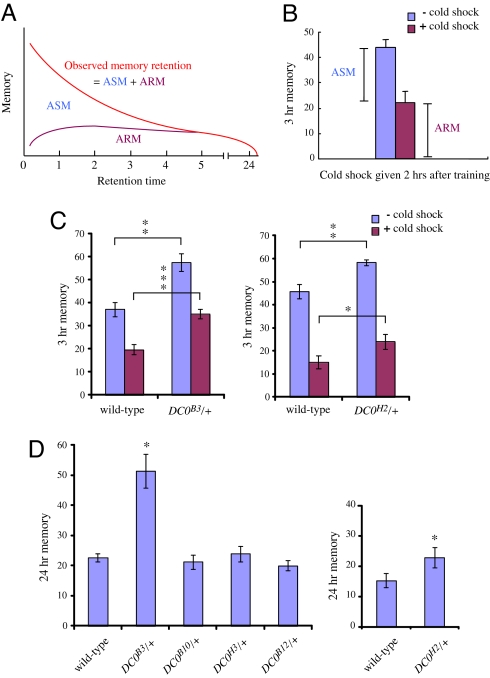Fig. 2.
DC0B3/+ and DC0H2/+ increase ARM. (A) Schematic memory retention curve demonstrating that observed memory retention consists of the sum of an early phase of memory, ASM, and a later phase, ARM. ASM consists of STM and MTM and is gradually consolidated into ARM. (B) Schematic demonstrating that 3-h memory consists of an ASM component and an ARM component. The ARM component can be specifically measured by cold-shocking the flies (cold shock anesthesia) 1 h before testing. Doing so specifically erases the ASM component of memory. ASM can be calculated by subtracting ARM from total 3-h memory. (C) DC0B3/+ and DC0H2/+ significantly improve total 3-h memory (P < 0.01 as assayed by t test). They also improve the cold shock-resistant ARM component of 3-h memory to the same extent (P < 0.05 as assayed by t test). Thus, these DC0 mutations increase ARM and not ASM. n ≥6 for all data points. (D) ARM can also be measured as 24-h memory after 10 massed trainings. ARM after massed training is significantly increased relative to wild type in DC0B3/+ (P < 0.05 as assayed by 1-way ANOVA) and DC0H2/+ (P < 0.05 as assayed by t test), whereas it remains unchanged in DC0B10/+, DC0H3/+, and DC0B12/+ lines. Two separate panels are shown in D because these experiments were performed at different times. Although there is some variability in 24-h memory measured in wild-type flies, both DC0B3/+ and DC0H2/+ always show improved ARM relative to wild-type. n = 5–7. *, P < 0.05; **, P < 0.01; ***, P < 0.001.

